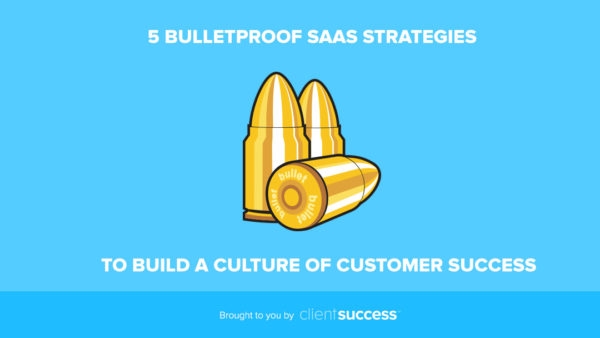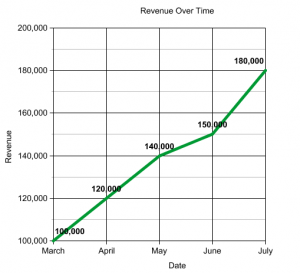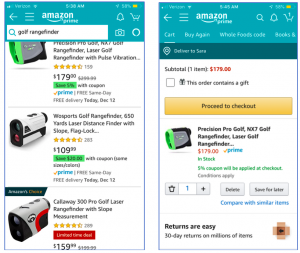— July 18, 2017

As SaaS organizations of any size can attest to, winning new clients is only half the battle. The real testament to a company’s product, culture, and employees is showcased in the success of its customers. Customer retention should not only be at the top of any executive’s priority list, it should be a priority for the entire company, and every employee and every team should own a stake in customer success.
Below we’ll share 5 bulletproof strategies any organization can leverage immediately to build and grow a winning customer success culture from the ground up:
5 Strategies to Build Customer Success as a Company Culture
1. Make a Culture of Success the Top Priority Across the Organization
For SaaS companies, it’s foundational that every single department feel dedicated to creating a culture of customer success. The key to ensuring every employee shares this outlook is for metrics or qualitative goals to be tied to each department and each role, designed to measure customer satisfaction and success.
This culture of success goes far beyond the CSM role alone. The marketing department, for example, can be incentivized to capture success stories from customers and include current customers in outbound marketing campaigns. Product teams can communicate directly with customers on what features are well received and used with purpose, and which should be evaluated. Even with finance and administration teams, the key is to open up a direct line of communication between customers and your internal teams to streamline processes and to make sure customers know they are the priority and lifeblood of your business.
2. Ensure CSMs Are Aligned to Customers’ Goals & KPIs
The foundation to cultivating a long-term, mutually beneficial partnership between your SaaS organization and your customers is truly understanding your clients from the inside out. Our Founder & CEO, Dave Blake, calls this “going high and wide,” meaning your team must establish a solid relationship with everyone associated with your business, from the decision makers to the users and beyond.
Wondering what questions you should ask to get to the root of individual goals and KPIs? Think of questions like:
- What are their team goals for your solution within their company?
- What are their most important KPIs?
- How are they personally measured or compensated?
- Did they have a role in choosing your solution?
Once this information is identified and understood, it’s now the CSM’s responsibility to tailor the relationship and the solution to what matters most to the customer – and in turn realize what will ultimately make that customer successful.
3. Ask For Internal & External Feedback… And Use It
As Entrepreneur magazine points out in this recent article, one of the best ways you can show your customers you care is by asking them for feedback, responding to their suggestions, and making the necessary adjustments. The article suggests the following strategy:
- Ask your customers what’s on their minds on a fairly regular basis. This can include feedback on any number of topics, from their sales processes to a recent service experience to their thoughts on your company’s mission and values.
- Listen to everything your customers have to stay, both through surveys and through less traditional methods like social media. Creating a social group and enabling clients to engage with each other promotes a sense of community and togetherness between your customers.
- Respond to your customers quickly and politely, whether they are raising a compliment or a complaint. If there is a problem, try to fix it as soon as possible so your customer knows you are listening and that you care.
- Adapt your business and your product based on what you are hearing from customers. This will help you retain your clients in the long-term, as well as help attract new clients who may have the same ideas.
4. Set Customer Expectations Early & Stick To Them
From the moment the deal closes to the kick-off call, it’s important to understand what commitments were made (on both sides), what products/services were sold, what timelines were set, and any other promises that were made. Ensuring these expectations are out in the open early in customer meetings not only helps promote retention, but also:
- Proves to your customer that you have clearly prioritized your relationship with them (especially if you deliver well before an agreed upon deadline).
- Eliminates any uncertainty in your relationship, both on your company’s side as well as your customer’s. This will give both of you some much needed peace of mind.
- Develops KPIs early enough in your customer’s relationship timeline that will help both sides succeed in reaching critical goals and milestones as a team.
5. Be Proactive with Customer Needs
Sometimes customer success teams fall into the trap of viewing their role as focused solely on retaining customers, rather than growing current accounts. Just simply going through the standard activation process with occasional touch points and pre-scheduled calls can often lead to high churn rates and dissatisfied customers
Instead, CSMs should approach new customers with an offensive mindset and focus on how to proactively drive value and promote growth within accounts. In reality, clients won’t be scared off by an offensive-minded onboarding or activation process. As Dave Blake explains in this recent blog post, these proactive CSMs actually develop deeper relationships with their customers, better understand their key business objectives, and can transition this understanding into higher retention rates and growth.
Check out our resources below for more customer success best practices and insights for how your organization can approach customer success with the customer at the center.
Business & Finance Articles on Business 2 Community
(56)
Report Post








